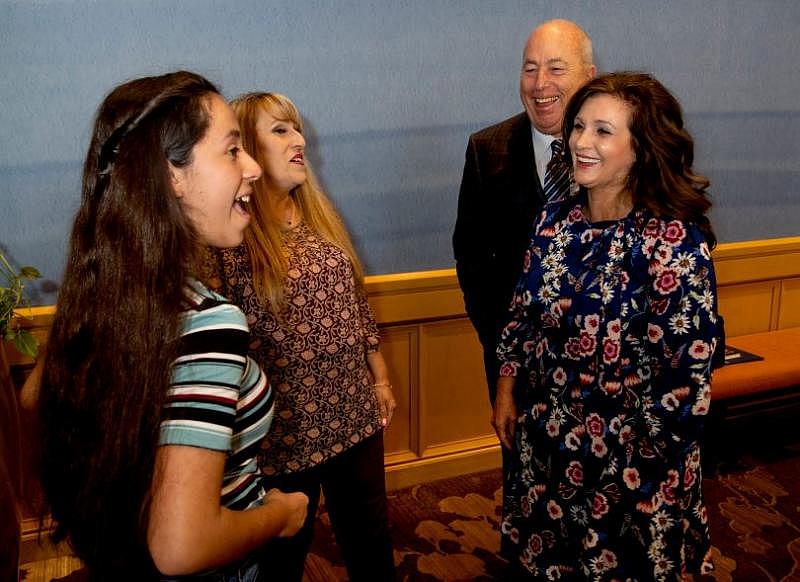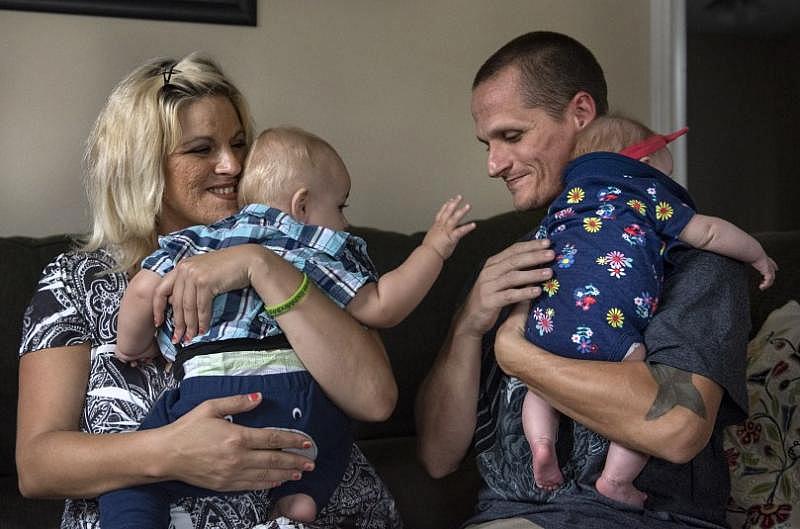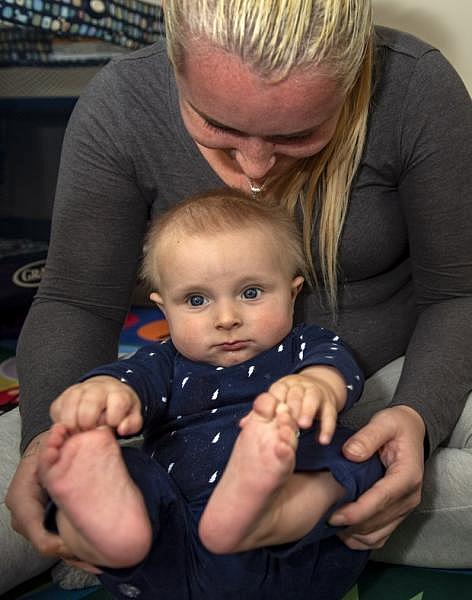Born on drugs: For addicted moms with babies, the system’s success doesn’t always mean the same thing
This series was produced with the support of the USC Annenberg Center for Health Journalism Impact Fund.
Other stories in this series include:
Born on drugs: The goal is to keep kids with parents. Sometimes, that’s dead wrong
Born on drugs: Babies from addicted moms are increasing at an alarming rate in California
Born on drugs: Predictions about crack babies didn’t come true, offering hope for opioid era
Lawmakers vow to push stiffer regulations on addiction treatment in California

Yvette Estrada and her daughter Elainna, 14, helped honor Toni and John Ginger at the Ambassador Luncheon for the Orangewood Foundation in Costa Mesa, CA on Friday, November 2, 2018. The Gingers received the General William Lyon Crystal Vision Philanthropy Award for their more than 20 years of foster parenting. Elainna was one of the kids they fostered from her birth until about 3 months old.
(Photo Credit: Paul Bersebach, Orange County Register/SCNG)
Yvette Estrada’s father packed up and left on Christmas Day, when she was 12.
That, she said, was the beginning of her pain.
There were older cousins, cigarettes, beer. Soon, Estrada was messing with cocaine, speed, PCP. Pregnancy couldn’t stop her: The night before she went into labor, in 2004, she got high on meth. Her baby girl was born “pos-tox” — meaning drugs were in the infant’s blood — then swept into state custody and placed in foster care.
“I was broken,” said Estrada, now 50, of La Habra.
“I didn’t know what to do except stick a needle in my neck. I didn’t know how to be a mom. I didn’t how to how to be nothing.”
‘Legal kidnapping?’
Despite the best intentions of parents and the child welfare system, reunification of children and their biological parents is elusive for most.
In 2007, 57 percent of kids who entered the system — the majority of whom were touched by addiction, according to national statistics — were reunited with their families within 18 months. By 2016, that reunification rate was down to 47 percent, according to data from the California Child Welfare Indicators Project at UC Berkeley.
The outlook was far grimmer for parents of newborns. In 2007, 38 percent of infants (less than one month old when they entered the system) in the system reunited with their families within 18 months. By 2016, that was down to 26 percent.
And while the overall number of children in the system plunged nearly 50 percent over nearly two decades, the number of infants shot up more than 9 percent.
Elainna Estrada, 14 and her mom Yvette, left, talk with Toni and John Ginger at the Ambassador Luncheon for the Orangewood Foundation in Costa Mesa, CA on Friday, November 2, 2018. The Gingers received the General William Lyon Crystal Vision Philanthropy Award for their more than 20 years of foster parenting. Elainna was one of the kids they fostered from her birth until about 3 months old. (Photo Credit: Paul Bersebach, Orange County Register/SCNG)
Some parents are starting to fight back.
In San Francisco, Santa Clara, Contra Costa, Walnut Creek, Monterey and Martinez, hundreds of parents who’ve lost children have protested in front of family courts, accusing child protection workers of misconduct. They assert that kids are removed intentionally and for profit, and say the system thrives on human “merchandise” so it can claim federal money and expand its “unchecked power.”
Approximately 200 people attend the March for Family Rights held in Walnut Creek on May 8, 2018. (Photo Credit: Stephen James/cjbns.org)
he marches were organized by Parents Against CPS Corruption and supported by Children’s Lives Matter. In August, recall petitions were filed against three Contra Costa judges.
“What they did was take a family struggling because of divorce and separation, and turn it into an extreme and constant trauma, which was so much worse than anything that happened before they were involved,” said Michelle Chan, founder of Parents Against CPS Corruption, about her own experience.
In 2016, as she and her husband battled over custody of their then-3-year-old son, charges of substance abuse and domestic violence flew. Chan claimed the social worker had it out for her and filed false reports. Her son was taken away. Chan fought back and ultimately regained custody, but the experience was devastating.
“The system is supposed to help families, not hurt them,” Chan said.
Critics say states have a perverse financial incentive to take children from their parents.
California spent $4.1 billion on child welfare in 2014, with more than half of it, $2.3 billion, coming from the federal government, according to an analysis by the Annie E. Casey Foundation. Most of that federal money — 58 percent — was spent on placing kids in new homes.
Twenty years ago, the feds began paying “adoption incentives” to states as a way to encourage them to move children into forever families more quickly and to prevent those children from growing up in foster care.
Nationwide, those payments have totaled $639 million since the program’s inception. California during that time has been the second biggest recipient (after Texas) of adoption incentive money, totaling $53.9 million, according to federal data.
In 2016, there were 6,542 adoptions of children protected by the state of California, according to federal statistics. That’s down 25 percent from 2000, though the state’s foster care caseload has plunged nearly 50 percent over the same time period.
San Jose attorney Joseph Kostmayer likened dependency court to the Star Chamber of 16th century England — a secret court that became a tool for social and political oppression through the arbitrary use and abuse of power.
“What we have in dependency court is a civil procedure imbued with penalties of a criminal nature,” Kostmayer said. “It doesn’t have the protections that are part of normal criminal law. And it’s conducted in secret. ”
Sensitive to such criticisms, Michael Nash — then presiding judge of Los Angeles County Children’s Court — ordered that dependency courts open to the public in 2012. Openness, he argued, would bring accountability to the process.
Advocates balked. Nash’s order intruded on the privacy of children who were already suffering, they argued. The Children’s Law Center, which represents most children in the Los Angeles County system, asked the state appeals court to overturn Nash’s order. It did so and, by 2014, proceedings were secret again.
Fears about abuse of power and official incompetence are not unfounded.
The County of Orange had to pay Deanna Fogarty-Hardwick $9.6 million in 2011, after two social workers lied and fabricated evidence to justify the removal of Fogarty-Hardwick’s two daughters. The social workers acted with malice, higher courts concluded. Her case did not involve drug-related allegations.
Child welfare agencies in San Joaquin, Riverside and Los Angeles counties have been reeling from charges of gross negligence, often in cases that involved addiction. Eight-year-old Gabriel Fernandez of Palmdale and 10-year-old Anthony Avalos of Lancaster died after child protection workers received more than a dozen reports of suspected abuse about each, but didn’t open cases. Fernandez’s mother had a history of drug use, and told officials she was taking massive doses of opioids in the months leading up to her son’s death.
Three-year-old Mariah Mustafa died in Stockton three years ago after ingesting meth in the foster home where she’d been placed to protect her from a drug-abusing mother.
‘Impossible Imperative’
Social workers on the front lines of family trauma face a task that can carry life-or-death consequences.
“We have developed this field that is so imperative, so essential for kids’ safety, but it’s full of contradictions and moral dilemmas that have no easy answers. How do we make the right decision?” asked Jill Duerr Berrick, professor in UC Berkeley’s School of Social Welfare and author of “The Impossible Imperative: Navigating the Competing Principles of Child Protection.”
The competing goals of social welfare — Keep that family together! Protect that child! — mean that, with every decision made, something is lost.
“I mean that quite profoundly,” Berrick said. “Kids might lose their parents. Parents might lose their children. Siblings might lose connections with one another. Those losses are very, very real. You have to think through, ‘Which loss is going to be the least harmful? What can I do that is least harmful in this situation?’ “
Sometimes, people make mistakes. And while a child welfare worker’s error in judgment can have devastating effects — and the landslide of public opprobrium is swift and decisive — such errors are outliers, she said.
Statistics suggest she’s right. Only a tiny fraction of the children in California — 2,200 children — died or were seriously injured due to abuse or neglect in California between 2009 and 2018, according to state data. But the overwhelming majority of those deaths and injuries happened in families that officials knew were problematic — families that had involvement with the child protection system at some point prior to the tragedy, according to state data.
A parent’s right to rear children without state involvement is in constant play with a child’s right to be free from maltreatment. The pendulum of public policy swings back and forth, and the conflicting mandates have been debated by those inside the system for decades.
“You’re dealing with emergencies. You have to think on your feet, understanding that it can make or break a family if you don’t ask the right questions,” said Maria Burch, a social worker who screens child abuse hotline calls in Alameda County and who contributed to Berrick’s book. “And later you wonder, ‘Oh, man. Did I do the right thing? Did I forget something?’”

Burch can field 25 hotline calls in a single day. Even the risk assessment tools she uses are a guide, not a crystal ball, she wrote in the book. And while workers might think they’re part of a child welfare agency, they’re really doing child protection work. The two are quite different.
“Sometimes families have significant needs for help, but if their concerns aren’t about child maltreatment, we have to send them elsewhere,” Burch wrote.
She often wonders if the system errs on the side of under-involvement in families’ lives.
Success
Despite what can seem like insurmountable odds, sometimes — with grit, support and perhaps luck, reunification happens.
After she was born pos-tox in 2004, Yvette Estrada’s daughter went into foster care with Toni and John Ginger of Laguna Beach.
“I am not keeping your baby forever, Yvette,” Toni Ginger told Estrada. “You’re her mother. I’m going to give her back to you. You need to get better so I can give her back to you.”
It was an epiphany, Estrada said. “My social worker got me by the hand, put her hand on mine, and said, ‘We’re going to do this together.’”
Estrada found a Christian women’s home, started drug treatment and said she turned herself over to God. About 18 months later, Estrada got her daughter back.
“The first hope I got was from the people I thought were against me,” she said. “Whoever says that Social Services just wants to take your kids away, that’s a lie. They saved my life.”
Estrada has been sober for 14 years and now serves as a “parent partner” in the same dependency courtrooms where her own drama played out, showing struggling parents that change can happen. In November, when the Orangewood Foundation honored Toni and John Ginger for caring for some 175 infants over the years — many of them born drug-exposed — Estrada and her now-14-year-old daughter were on hand to thank them.
At first, things looked grim for Cheyenne Easter and Jeremy Jones, as well.
In late 2017, they were trying to parent a new baby, adapt to living in an apartment after years of homelessness, and working to stay sober, all at the same time. It was too much. They started using again and fought outside their apartment. Easter was arrested on charges of domestic violence and Jones was too intoxicated to care for their child, three-month-old Sebastian. In October of last year, the boy was placed in foster care.
“I just felt like I lost everything again,” Jones said. “It broke my heart.”
Jones returned to the tent camp beneath the 22 freeway in Orange, where he and Easter first met. “I was crying my eyes out, drinking more than I ever drank,” he said. “I would drink until I passed out. And then I would wake up and start drinking again.”
Easter wound up at the Heritage House emergency shelter for women, and soon was stunned to learn that she was pregnant again.
Jones visited her on Christmas Day. They wept. “I was like, ‘OK, are you ready?’” Easter said. “‘Are you ready to grow up? Let’s do this. Let’s go.’”
With the help of Rose Wolfrum, the director of family and children’s stabilization programs at the Illumination Foundation, an organization that helps homeless people, the couple got down to work tackling the to-do lists given to them by social workers. They finished drug and alcohol treatment, took parenting classes, got into permanent housing. When their second baby, Charlotte, was born in July of 2018, she too was swept into state custody — until tests proved there were no drugs in her system. A month later, Charlotte was entrusted to her parents’ care.
Soon, Easter and Jones were allowed unsupervised visits with Sebastian. Then they were allowed to keep him overnight. In October, the court allowed Sebastian to come home for a 60-day trial. And, earlier this month, they got their baby boy back.
Cheyenne Easter and Jeremy Jones with Sebastian, 13 months and Charlotte, 3 months, spent years living on the streets addicted to drugs and alcohol. They journeyed into the legal system and eventually into sobriety. They are hoping to be awarded full custody of their children early next year. (Photo Credit: Mindy Schauer, Orange County Register/SCNG)
“I’m not here to bash CPS because we needed the support, we needed the guidance, we needed the stepping stones that they gave us to be a success story,” Easter said as 14-month-old Sebastian offered kisses to 3-month-old Charlotte.
“Hopefully, one day, we can give back to the people who gave us so much.”
Easter — who twirled in golf course sprinklers the night she and Jones met, imploring God and Mickey Mouse for a happily-ever-after — believes she’s finally found it.
“I feel like I’m myself again, after all these years.”
Hope
Noah lay on his back in the nursery at MFI Recovery in Riverside, joyfully kicking his legs and gurgling at anyone who met his gaze. When his mom, Leah Renee Tonelli, entered the room, the baby lit up like the nearby Christmas tree, cozying onto her lap as she presented him with toy after toy. She smiled as he attempted to insert each into his tiny mouth.
Outside, Maryann Alfaro dashed across the green grass to retrieve the blow-up baseball that 17-month-old Ezekiel launched her way. They romped on the lawn, chasing the ball back and forth, until Alfaro fell to her knees and squeezed him tight, her face startlingly alight.
Each of the 30-or-so women living at MFI had an unsettling story to tell — of drinking bleach mixed with baking soda to avoid testing positive for drugs, of losing kids to the system, of jail cells, misery, domestic violence, dejection. After learning they were pregnant – or having children removed from their care – they wound up at MFI’s door, often angry and belligerent, sick and desperate, seeking to detox or to just get child protective services off their backs.
Leah Renee Tonelli plays with her 7-month-old son Noah at the MFI Recovery Center in Pasadena where they are both staying. (Photo Credit: Mindy Schauer, Orange County Register/SCNG)
The rambling building on nearly an acre near downtown Riverside teemed with mothers, mothers-to-be and their children, living together for up to seven months in a shared quest to face ugly truths, forgive themselves for transgressions, and forge happy, productive, sober lives. Sometimes swiftly, sometimes not, the support they found there gave them strength. They attended parenting classes and counseling sessions, learned about relapse prevention and running a household, did yoga. They also dared to imagine the day they’d give birth, and all the days after.
Medication-assisted treatments – and a doctor’s expertise – were available for women struggling with opioid addiction. Hands-on help awaited all the new moms returning from the hospital with newborns. Discharge planning helped them land on their feet after graduating.
“I put my kids through hell,” said Stacy Walker, who has had five children taken from her care — three to live with her sister, one with the dad’s family, and one in foster care. Her sixth — a newborn baby daughter; pink and perfect — slept peacefully in the nursery; Walker’s chance to get it right.
“I would never go back to that life,” Walker said. “I’m worth something.”
[This story was originally published by The Orange County Register.]

